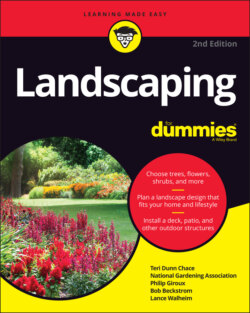Читать книгу Landscaping For Dummies - Lance Walheim - Страница 97
Stringing out the rest of a shape
ОглавлениеAfter you establish the first line, finish stringing the perimeter of the rest, whether it’s your new patio, deck, or another item. Just follow these steps:
© John Wiley & Sons, Inc.
FIGURE 4-2: Lay out a line.
1 To establish a right angle and thus continue laying out the shape, go down your existing line 3 feet (.9 m) and set a stake.Using a carpenter’s square, go 4 feet (1.2 m) down in the perpendicular direction and set another stake. Put nails on top of each, as you did when you laid out the initial line.
2 Measure the diagonal between the two new stakes.If it’s 5 feet (1.5 m), you’re good, you made a right angle (you have a good carpenter’s square). If it isn’t, adjust the stake on the line that lacks a string yet (the one 4 feet, 1.2 m away) until it all checks out, that is, the numbers form a triangle with a right angle. For checking larger distances, use multiples of 3, 4, and 5 feet, such as 9, 12, and 15, or 12, 16, and 20 feet (in metric, that would be .9, 1.2, and 1.5 m, such as 2.7, 3.6, and 4.8 m, or 3.6, 4.9, and 6.1 m).
3 Continue down your new line the designed/desired distance, and put in another stake at the end, again topping it with a partially pounded-in nail.Run mason’s twine the full length.
4 Double-check your diagonals.This step requires math. Get out a calculator. We deploy the Pythagorean Theorem. (Yes, this is your tenth grade trigonometry class, back to haunt you!):a2 + b2 should = c2a is the length of one side, b is the length of the other side, and c is the diagonal distance between the corners.Adjust the stakes until it all checks out. In some situations, such as attaching a deck or patio to the house, your layout may look cockeyed because the house walls, driveway, or other existing features aren’t square. If so, fudge the layout slightly to bring the side of the layout in line with the existing feature.
5 When you’re satisfied, mark the layout on the ground.If the stringlines are for guiding excavation — for fence posts or a patio base, for example — you need to mark the ground for digging. Where such marks must be perfectly accurate, hold a plumb bob close to the ground, with its string brushing against the stringline, and mark the ground directly under the bob with spray paint, flour, chalk, or colored cloth held down with a nail. Make several marks, as needed.
